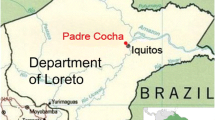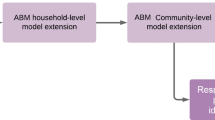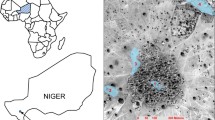Abstract
The Camargue, a region in southern France, is considered a potential site for malaria reemergence. All the suitable factors of the disease transmission system are present—competent mosquito vectors, habitats for their breeding, and susceptible people—except for the parasite. The objective of this study was to test potential drivers of malaria reemergence in this system after possible changes in biological attributes of vectors, agricultural practices, land use, tourism activities, and climate. Scenarios of plausible futures were formulated and then simulated using a spatially explicit and dynamic multiagent simulation: the MALCAM model. Scenarios were developed by varying the value of model inputs. Model outputs were compared based on the contact rate between people and potential malaria vectors, and the number of new infections in case of reintroduction of the parasite in the region. Model simulations showed that the risk of malaria reemergence is low in the Camargue. If the disease would reemerge, it would be the result of a combination of unfavorable conditions: introduction of a large population of infectious people or mosquitoes, combined with high levels of people–vector contacts resulting from significant changes in land use, tourism activities, agricultural policies, biological evolution of mosquitoes, and climate changes. The representation in the MALCAM model of interactions and feedbacks between different agents, and between agents and their environment, led in some cases to counterintuitive results. Results from scenario analyses can help local public health authorities in policy formulation.







Similar content being viewed by others
References
Alten B, Kampen H, Fontenille D (2007) Malaria in Southern Europe: resurgence from the past? In: Emerging Pests and Vector-borne Diseases in Europe, Takken W, Knols BGJ (editors), Wageningen: Wageningen Academic Publishers, pp 35-58
Carpenter SR, Pingali PL, Bennett EM, Zurek MB (2005) Ecosystems and Human Well-being: Scenarios, Volume 2, Washington, D.C.: Island Press
Coosemans M, Guillet P (1999) Individual protection against mosquito bites [in French]. Médecine et Maladies Infectieuses 29(Suppl 3):390-396
Dervieux A (2005) La difficile gestion globale de l’eau en Camargue (France): le Contrat de delta. La revue électronique en sciences de l’environnement. Vertigo 6(3):11
Doudier B, Bogreau H, DeVries A, Ponçon N, Stauffer WM, Fontenille D (2007) Possible autochthonous malaria from Marseille to Minneapolis. Emerging Infectious Diseases 13:1236-1238
Kettle DS (1995) Medical and Veterinary Entomology, Wallingford, UK: CAB International
Kuhn KG, Campbell-Lendrum DH, Armstrong B, Davies CR (2003) Malaria in Britain: past, present, and future. Proceedings of the National Academy of Sciences 100(17):9997–10001
Langewiesche K (2005) Evaluation des risques d’émergence, d’installation et de diffusion du paludisme en France dans un contexte de changement global (environnement et climat) projet EDEN, volet sciences sociales. Montpellier: France
Linard C, Ponçon N, Fontenille D, Lambin EF (2008) A multi-agent simulation to assess the risk of malaria reemergence in southern France. Ecological Modelling 220:160–174. doi:10.1016/j.ecolmodel.2008.09.001
Martens P, Kovats RS, Nijhof S, de Vries P, Livermore MTJ, Bradley DJ, Cox J, McMichael AJ (1999) Climate change and future populations at risk of malaria. Global Environmental Change 9(Suppl 1):S89-S107
Mcdonald G (1957) The Epidemiology and Control of Malaria, London: Oxford University Press
Nakicenovic N, Alcamo J, Davis G, deVries Hea (2000) Intergovernmental Panel on Climate Change (IPCC) Special Report on Emission Scenarios (SRES), Cambridge: Cambridge University Press
Ogden NH, Bigras-Poulin M, Hanincová K, Maarouf A, O’Callaghan CJ, Kurtenbach K (2008) Projected effects of climate change on tick phenology and fitness of pathogens transmitted by the North American tick Ixodes scapularis. Journal of Theoretical Biology 254:621-632
Ogden NH, Maarouf A, Barker IK, Bigras-Poulin M, Lindsay LR, Morshed MG et al (2006) Climate change and the potential for range expansion of the Lyme disease vector Ixodes scapularis in Canada. International Journal for Parasitology 36(1):63-70
Pages F, Orlandi-Pradines E, Corbel V (2007) Vecteurs du paludisme: biologie, diversité, contrôle et protection individuelle. Médecine et Maladies Infectieuses 37:153-161
Petit D, Rivière-Honegger A (2006) Processus territoriaux et gestion de l’eau en Camargue gardoise. Développement Durable et Territoires 6
Ponçon N, Toty C, L’Ambert G, Le Goff G, Brengues C, Schaffner F et al (2007a) Biology and dynamics of potential malaria vectors in Southern France. Malaria Journal 6(18)
Ponçon N, Toty C, L’Ambert G, Le Goff G, Brengues C, Schaffner F et al (2007b) Population dynamics of pest mosquitoes and potential malaria and West Nile virus vectors in relation to climatic factors and human activities in the Camargue, France. Medical and Veterinary Entomology 21:350–357
Ponçon N, Balenghien T, Toty C, Ferré J, Thomas C, Dervieux A et al (2007c) Effects of local anthropogenic changes on potential malaria vector Anopheles hyrcanus and West Nile virus vector Culex modestus, Camargue, France. Emerging Infectious Diseases 13:1810-1815
Ponçon N, Tran A, Toty C, Luty A, Fontenille D (2008) A quantitative risk assessment approach for mosquito-borne diseases: malaria reemergence in Southern France. Malaria Journal 7(147)
Reiter P (2000) From Shakespeare to Defoe: malaria in England in the little ice age. Emerging Infectious Diseases 6:1-11
Rodhain F, Charmot G (1982) Evaluation des risques de reprise de transmission du paludisme en France. Médecine et Maladies Infectieuses 12:231-236
Rogers DJ, Randolph SE (2000) The global spread of malaria in a future, warmer world. Science 289(5485):1763-1766
Schoepke A, Steffen R, Gratz N (1998) Effectiveness of personal protection measures against mosquito bites for malaria prophylaxis in travelers. Journal of Travel Medicine 5:188-192
Schröder W, Schmidt G (2008) Mapping the potential temperature-dependent tertian malaria transmission within the ecoregions of Lower Saxony (Germany). International Journal of Medical Microbiology 298(Suppl 1):38-49
Thomas CJ, Davies G, Dunn CE (2004) Mixed picture for changes in stable malaria distribution with future climate in Africa. Trends in Parasitology 20:216-220
Tran A, Ponçon N, Toty C, Linard C, Guis H, Ferré J et al (2008) Use of remote sensing to map larval and adult populations of anopheles species in Southern France. International Journal of Health Geographics 7(9)
van Lieshout M, Kovats RS, Livermore MTJ, Martens P (2004) Climate change and malaria: analysis of the SRES climate and socio-economic scenarios. Global Environmental Change 14:87-99
van Notten PWF, Rotmans J, van Asselt MBA, Rothman DS (2003) An updated scenario typology. Futures 35:423-443
Wilensky U (1999) NetLogo, Northwestern University, Evanston, IL: Center for Connected Learning and Computer-Based Modeling. http://ccl.northwestern.edu/netlogo/ Accessed 8 Sept 2008
Willott E (2004) Restoring nature, without mosquitoes? Restoration Ecology 12:147-153
Acknowledgments
This research was partially funded by EU grant GOCE-2003-010284 EDEN and the paper is catalogued by the EDEN Steering Committee as EDEN122 (www.eden-fp6project.net). The French Ministry of Agriculture paid the salary of Nicolas Ponçon. The contents of this publication are the responsibility of the authors and do not necessarily reflect the views of the European Commission. The authors thank Annelise Tran (CIRAD) for providing the Landsat classification.
Author information
Authors and Affiliations
Corresponding author
Rights and permissions
About this article
Cite this article
Linard, C., Ponçon, N., Fontenille, D. et al. Risk of Malaria Reemergence in Southern France: Testing Scenarios with a Multiagent Simulation Model. EcoHealth 6, 135–147 (2009). https://doi.org/10.1007/s10393-009-0236-y
Received:
Revised:
Accepted:
Published:
Issue Date:
DOI: https://doi.org/10.1007/s10393-009-0236-y




